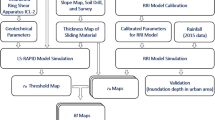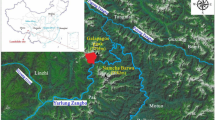Abstract
Shallow landslide occurrence is most common in rainy season in the form of flow of debris, costs heavy damages to the infrastructure and human lives. Early prediction framework of such disaster can help to mitigate such damages. The present work deals with prediction framework for initiation of debris flow, which is developed and validated with real case study. In order to test reliability of prediction framework, back analysis of very recent landslide debris flow accrued in the study area, Taliye village of Konkan region of Maharashtra, India on 22 July 2021 was carried out. Simulation results of landslide stability were compared with the leaky barrel-based rainfall-water saturation algorithm. Relations of landslide stability with the water saturation were established through physically based approach using Geo-Studio analysis module. Leaky barrel algorithm was used for study location for monitoring effect of rainfall on water saturation. The result confirms the good predictability of landslide occurrence through a developed early prediction framework. The methodological framework was presented in this paper for prediction of shallow landslide occurrence and recommended for real-time monitoring of landslide prone locations.














Similar content being viewed by others
Abbreviations
- EWS:
-
Early warning system
- LSEWS:
-
Landslide early warning system
- SWCC:
-
Soil water characteristics curve
- LEM:
-
Limit equilibrium model
- VWC:
-
Volumetric water content
- PVC:
-
Poly vinyl chloride
- °C:
-
Degree Celsius
- γd :
-
Dry density
- G:
-
Specific gravity
- γw :
-
Density of water
- e:
-
Void ratio
- W:
-
Percentage water content
- Sr :
-
Degree of saturation
- C:
-
Cohesion
- Φ:
-
Angel of internal friction
- θ:
-
Volumetric water content
- I:
-
Rainfall intensity
- Z:
-
Rainfall stored in barrel
- Zc :
-
Capacity of system
- Δ:
-
Drainage rate
- Kd :
-
Drainage Coefficient
- T:
-
Time
References
Froude M J and Petley D N 2018 Global fatal landslide occurrence from 2004 to 2016. Natural Hazards and Earth System Sciences 18(8): 2161–2181. https://doi.org/10.5194/nhess-18-2161-2018
Wicki A, Lehmann P, Hauck C, Seneviratne S I, Waldner P and Stähli M 2020 Assessing the potential of soil moisture measurements for regional landslide early warning. Landslides 17(8): 1881–1896. https://doi.org/10.1007/s10346-020-01400-y
Sudani P and Patil K A 2023 Investigating effect of water saturation on stability of hill slope: Malin case study. Advances in Civil and Architectural Engineering. https://doi.org/10.13167/2023.26.9
Sudani P and Patil K A 2023 Evaluating the significance of saturation in shallow landslide failure: saturated–unsaturated soil perspective. Multiscale and Multidisciplinary Modeling, Experiments and Design.. https://doi.org/10.1007/s41939-023-00175-8
Sudani P and Patil K A 2023 Assessment of variation in degree of saturation due to rainfall for landslide study. Geotechnical Engineering Journal 54(2): 36–40
Sudani P, Patil K A and Kolekar Y A 2023 Historical development of landslide early warning system (LEWS): a review. Lecture Notes in Civil Engineering. https://doi.org/10.1007/978-981-19-7245-4_24
Michoud C, Bazin S, Blikra L H, Derron M-H and Jaboyedoff M 2013 Experiences from site-specific landslide early warning systems. Natural Hazards and Earth System Sciences 13(10): 2659–2673. https://doi.org/10.5194/nhess-13-2659-2013
Guzzetti F, Gariano S L, Peruccacci S, Brunetti M T, Marchesini I, Rossi M and Melillo M 2020 Geographical landslide early warning systems. Earth-Science Reviews 200: 102973. https://doi.org/10.1016/j.earscirev.2019.102973
Bogaard T A and andGreco R, 2016 Landslide hydrology: from hydrology to pore pressure. WIREs Water 3(3): 439–459. https://doi.org/10.1002/wat2.1126
Harilal G T, Madhu D, Ramesh M V and Pullarkatt D 2019 Towards establishing rainfall thresholds for a real-time landslide early warning system in Sikkim, India. Landslides 16(12): 2395–2408. https://doi.org/10.1007/s10346-019-01244-1
Guzzetti F, Reichenbach P, Ardizzone F, Cardinali M and Galli M 2006 Estimating the quality of landslide susceptibility models. Geomorphology 81(1–2): 166–184. https://doi.org/10.1016/j.geomorph.2006.04.007
Aleotti P 2004 A warning system for rainfall-induced shallow failures. Engineering Geology 73(3–4): 247–265. https://doi.org/10.1016/j.enggeo.2004.01.007
Lagomarsino D, Segoni S, Fanti R and Catani F 2013 Updating and tuning a regional-scale landslide early warning system. Landslides 10(1): 91–97. https://doi.org/10.1007/s10346-012-0376-y
Badoux A, Graf C, Rhyner J, Kuntner R and McArdell B W 2009 A debris-flow alarm system for the Alpine Illgraben catchment: design and performance. Natural Hazards 49(3): 517–539. https://doi.org/10.1007/s11069-008-9303-x
Baum R L and Godt J W 2010 Early warning of rainfall-induced shallow landslides and debris flows in the USA. Landslides 7(3): 259–272. https://doi.org/10.1007/s10346-009-0177-0
Bai S, Wang J, Thiebes B, Cheng C and Yang Y 2014 Analysis of the relationship of landslide occurrence with rainfall: a case study of Wudu County. China. Arabian Journal of Geosciences 7(4): 1277–1285. https://doi.org/10.1007/s12517-013-0939-9
Sudani P and Patil K A 2022 Evolution of early warning system for landslides. Disaster Advances 15(8): 46–59. https://doi.org/10.25303/1508da046059
Salciarini D, Brocca L, Camici S, Ciabatta L, Volpe E, Massini R and Tamagnini C 2019 Physically based approach for rainfall-induced landslide projections in a changing climate. Proceedings of the Institution of Civil Engineers - Geotechnical Engineering 172(6): 481–495. https://doi.org/10.1680/jgeen.18.00216
Wei Y, Wu X, Xia J, Miller G A, Cai C, Guo Z and Arash H 2019 The effect of water content on the shear strength characteristics of granitic soils in South China. Soil and Tillage Research 187: 50–59. https://doi.org/10.1016/j.still.2018.11.013
Mondini A, Carlà R, Reichenbach P, Cardinali M and Guzzetti F 2009. Use of a remote sensing approach to detect landslide thermal behaviour. In: EGU General Assembly Conference. 11, 7790
Abraham M T, Satyam N, Pradhan B, Segoni S and Alamri A 2022 Developing a prototype landslide early warning system for Darjeeling Himalayas using SIGMA model and real-time field monitoring. Geosciences Journal 26(2): 289–301. https://doi.org/10.1007/s12303-021-0026-2
Fiorillo F and Wilson R C 2004 Rainfall induced debris flows in pyroclastic deposits, Campania (southern Italy). Engineering Geology 75(3–4): 263–289. https://doi.org/10.1016/j.enggeo.2004.06.014
Keefer D K, Wilson R C, Mari R K, Brabb E E, Iii W M B, Ellen S D, Harp E L, Wieczorek G F, Alger C S and Zatkint R S 1987 Real-time landslide warning during heavy rainfall. Science 238(13): 921–925
Petley D 2021 The disastrous Taliye village landslide in Maharashtra. Landslide blog, India
Stark T D, Choi H and McCone S 2005 Drained shear strength parameters for analysis of landslides. J. Geotech. Geoenvironmental Eng. 131(5): 575–588. https://doi.org/10.1061/(asce)1090-0241(2005)131:5(575)
Watabe Y, Tanaka M and Kikuchi Y 2009 Practical determination method for soil parameters adopted in the new performance based design code for port facilities in Japan. Soils Found. 49(6): 827–839
Ali F, Farooq K, Mujtaba H, Riaz A and Ulhaq E 2016 Influence of saturation on rainfall generated landslides in shale along Murree-Kohala road. Pakistan J. Geol. Soc. India 88(6): 718–724. https://doi.org/10.1007/s12594-016-0539-x
Morgenstern N U and Price V E 1965 The analysis of the stability of general slip surfaces. Geotechnique 15(1): 79–93
Hiura H and Sassa K 1985. Estimation of the landslide drainage effect in use of tank model. In: A. Takei (Ed.), Procedings of international symposium on errosion, debris flow and disaster prevention pp. 355–360
Tan K S, Lim S B, Tan T L and Yang S L 1987. Landslide problems and their control in Singapore. In: Southeast Asian Geotechnical Conference., 25–36
Wilson R C and Wieczorek G F 1995 Rainfall thresholds for the initiation of debris flows at La Honda, California. Environmental & Engineering Geoscience 1(1): 11–27. https://doi.org/10.2113/gseegeosci.i.1.11
Acknowledgements
We express our gratitude to the AICTE-NDF Scheme (Application number 60400) for awarding us a research fellowship, which has enabled us to pursue our research endeavors. Additionally, we extend our appreciation to the College of Engineering Pune, which has facilitated our academic pursuits.
Author information
Authors and Affiliations
Corresponding author
Rights and permissions
About this article
Cite this article
Sudani, P., Patil, K.A. Early prediction framework for a rainfall-induced landslide: validation through a real case study. Sādhanā 48, 187 (2023). https://doi.org/10.1007/s12046-023-02242-9
Received:
Revised:
Accepted:
Published:
DOI: https://doi.org/10.1007/s12046-023-02242-9




